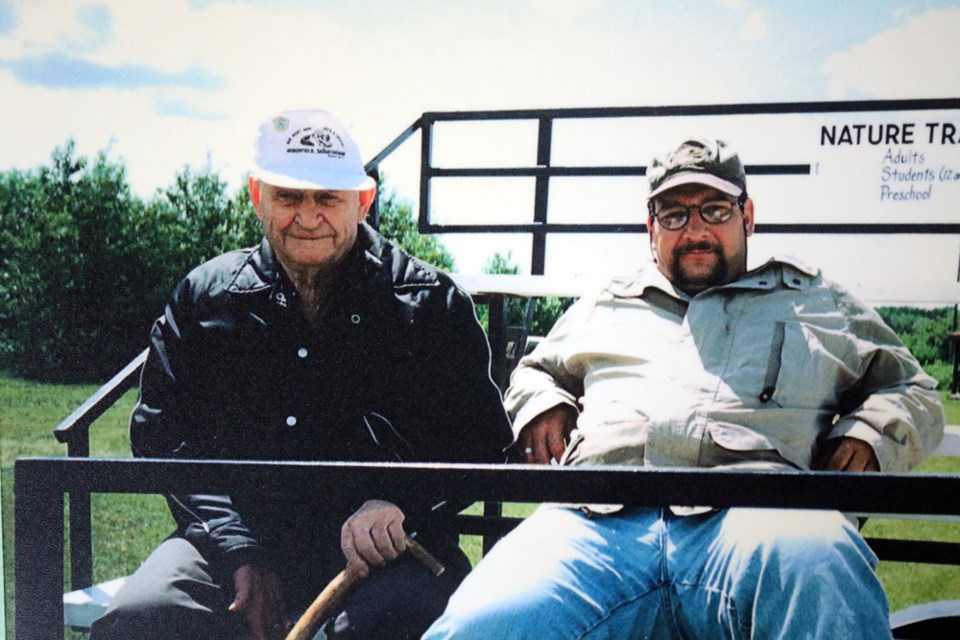Dickson Hardie was a retired farmer, living along the Carrot River east of Pasquia Regional Park. He would go along the river and look for fossils.
Hardie would use a screwdriver and stick it into the bank. If he hit something hard, he knew he’d have found a fossil.
“He sent these fossils to the [Royal Saskatchewan Museum] in Regina because he was sure that there was something fantastic in that river, that he didn’t know what it was,” said Susan Schroepfer, the general manager of Pasquia Park.
The fossils attracted the attention of Tim Tokaryk, a paleontologist with the museum. In 1988 Hardie and Tokaryk met and among the fossils Hardie had discovered, there were two new fossil bird species, one which was named after its discoverer.
Hardie showed Tokaryk where he found the fossils and in 1991, Tokaryk would make a discovery that would change Pasquia Regional Park, which has been around since 1967, forever.
“When I was walking the ledge many years ago, I happened to see three large vertebrate, large meaning that they were three to four inches in length and they were in sequence, which was strange,” he said in an interview on video.
Tokaryk thought he found a plesiosaur. It was actually a terminonaris robusta, an ancient crocodile that lived in a large, shallow ocean 92 million years ago where the Pasquia Hills are today.
“It took all fall and most of the winter until they got him out,” Schroepfer said. “They had tents over top of the dig site and at times, the weather was quite bad.”
The general manager said the discovery of the crocodile – named Big Bert by Tokaryk – is important for Pasquia Park.
“It’s incredible. It has brought a lot of people to the park, it is not something that very many parks have.”
A paleontology group was formed and they managed to get the funding to create a styrofoam replica of what Big Bert would have looked like, which is located in the park’s interpretive centre, now named after Hardie, today.
There’s also a replica skeleton of the ancient crocodile at the centre, which took a lot of lobbying by Schroepfer to bring to the park.
“I got the schoolkids, each one of the schoolkids from Carrot River, Zenon Park and Arborfield – the younger ones – to write a letter about how much it meant for Big Bert to come to Pasquia Park,” she said. “I got all of my towns and all of my RMs to write a letter.”
The effort, of course, was successful and in 2011 the replica arrived.
“We had a birthday celebration for Big Bert with the museum, government officials and many, many children, to welcome Big Bert home.”
Schoolchildren are important when it comes to Big Bert. Last year, Arborfield School students worked on a skit as part of an effort to have Big Bert declared Saskatchewan’s official fossil. It placed second, behind Scotty the T-rex.
“Every year, we have at least eight to 12 schools that come to visit,” Schroepfer said. “They have their year-end pool party and they always come to visit Big Bert and watch the video [Big Bert Country].”
The dig site where they found Big Bert is publically accessible. In the past, one could travel up the Andy Jamault Nature Trail, but due to heavy erosion from the Carrot River, the trail is now closed for safety reasons. Schroepfer said those wanting to see the site should stop at the interpretative centre, where staff will give directions. The centre opens in June.
The fossil has brought a lot of people to the park, with 437 people visiting last year.
Schroepfer said she hopes the rainy weather of the last few years will improve and that Royal Saskatchewan Museum come to the area to look for even more fossils that can be displayed at the park.
“We’re hoping that the museum will find the funding to be able to find more things on the river and bring them into the museum here.”



